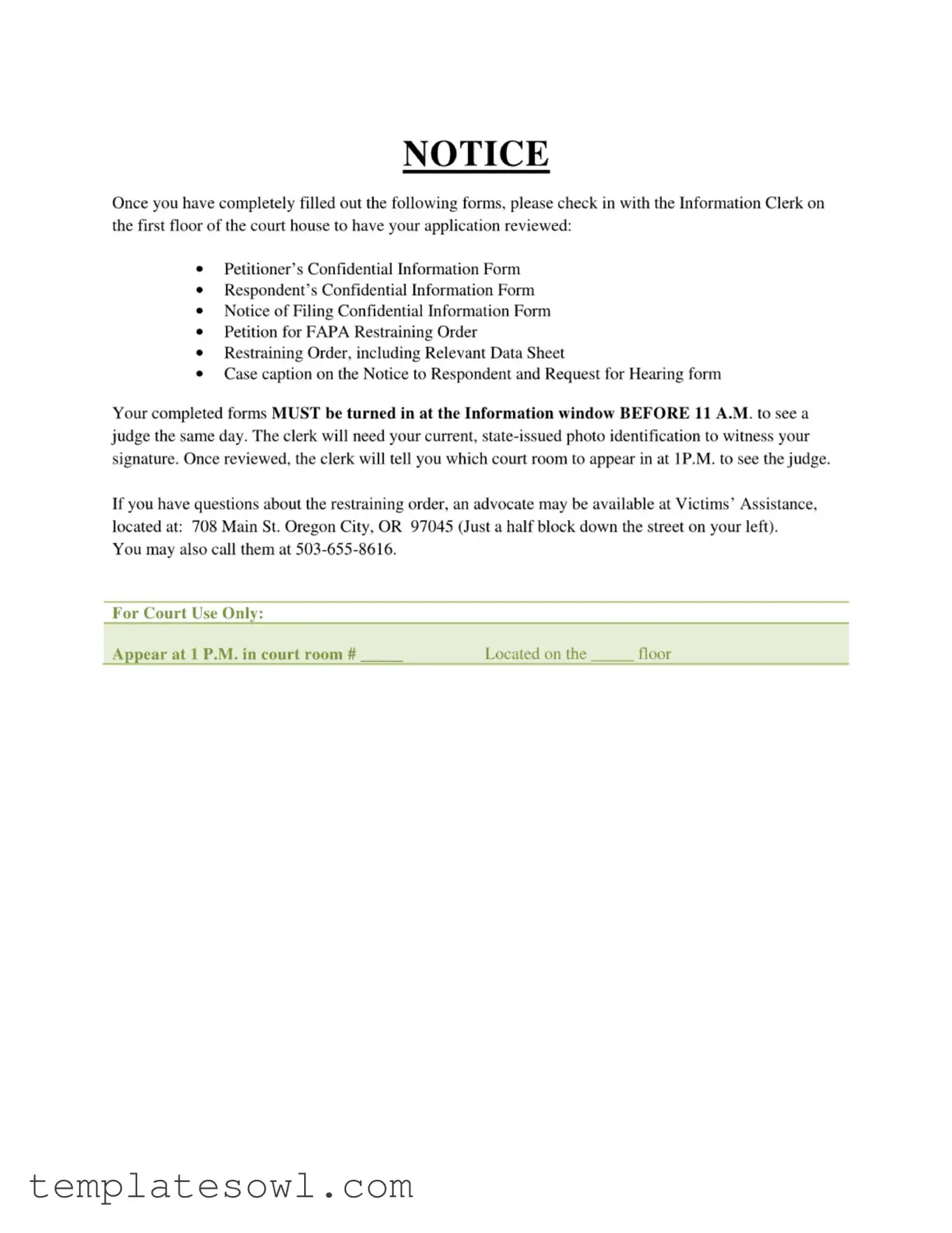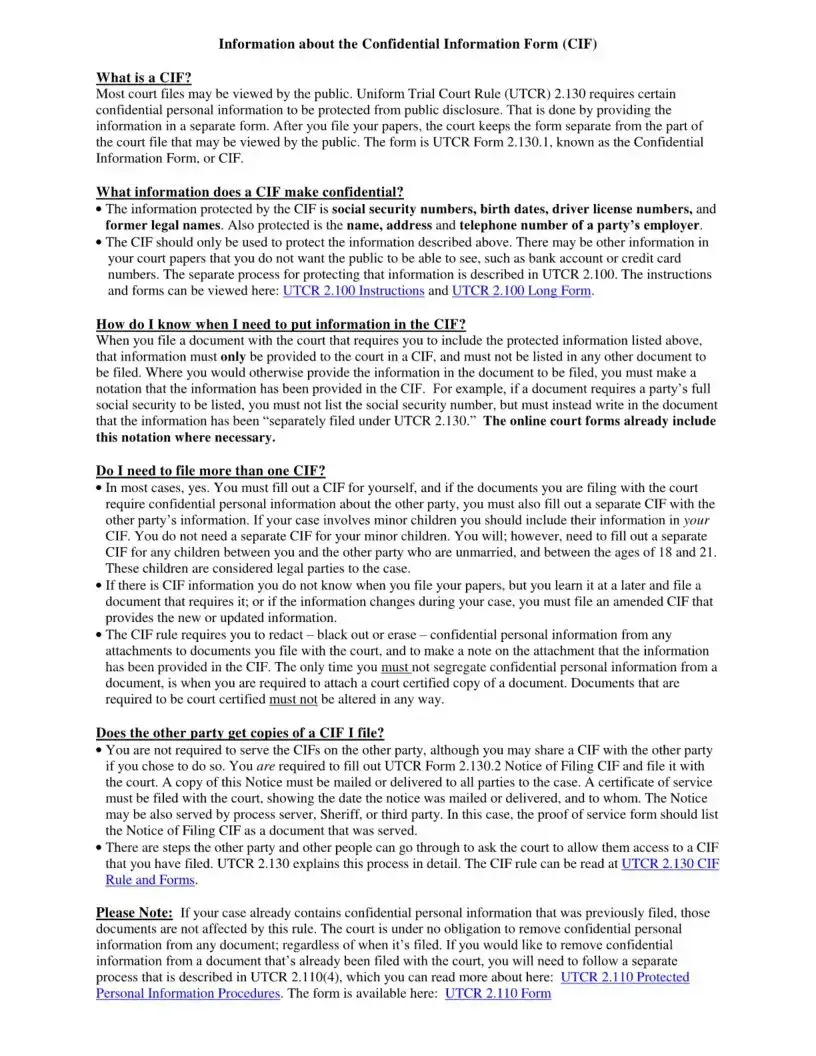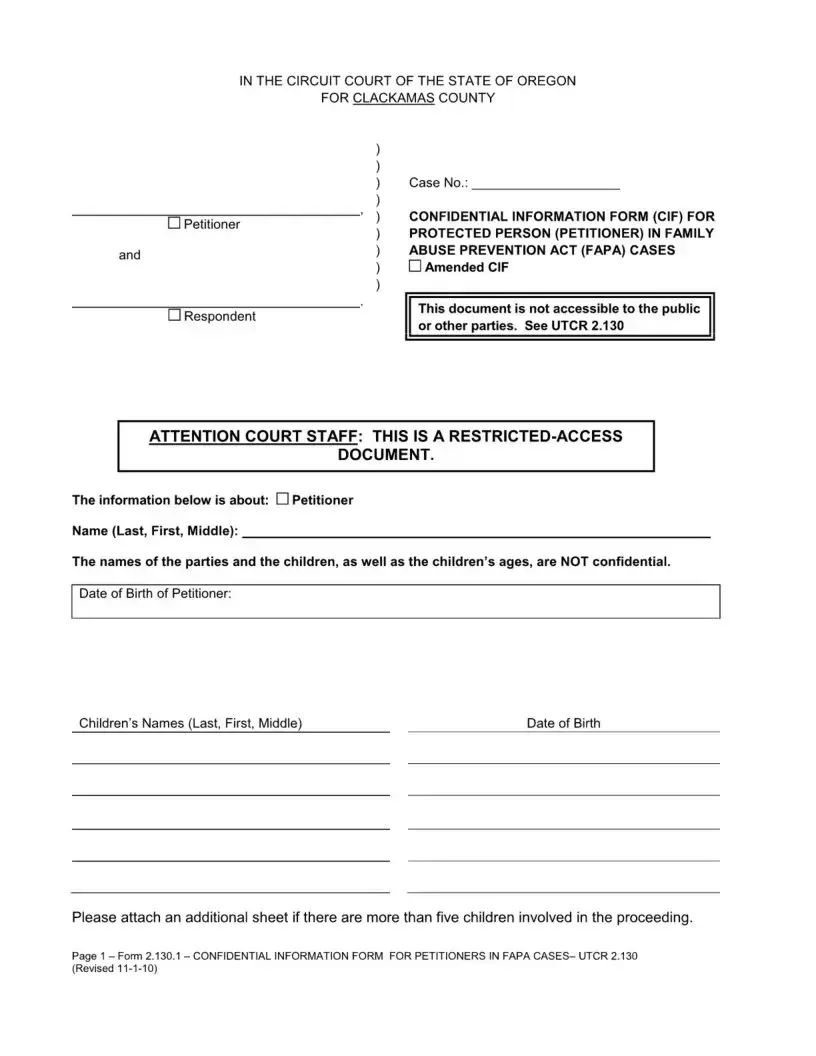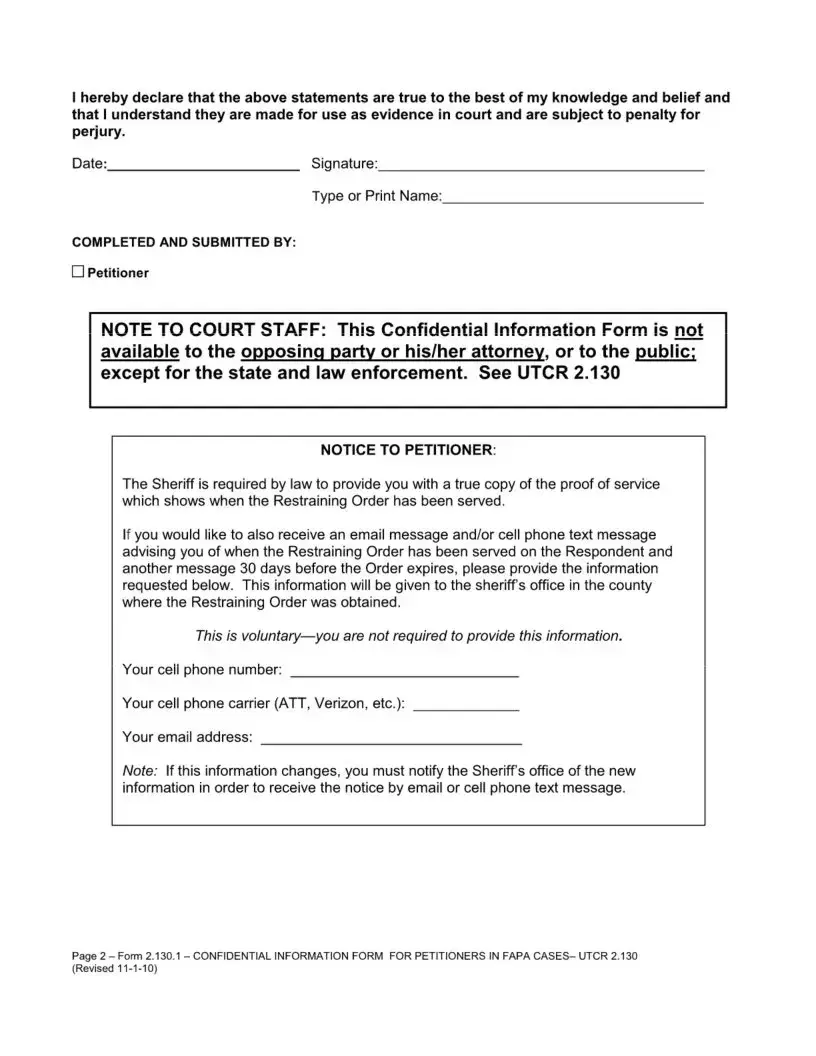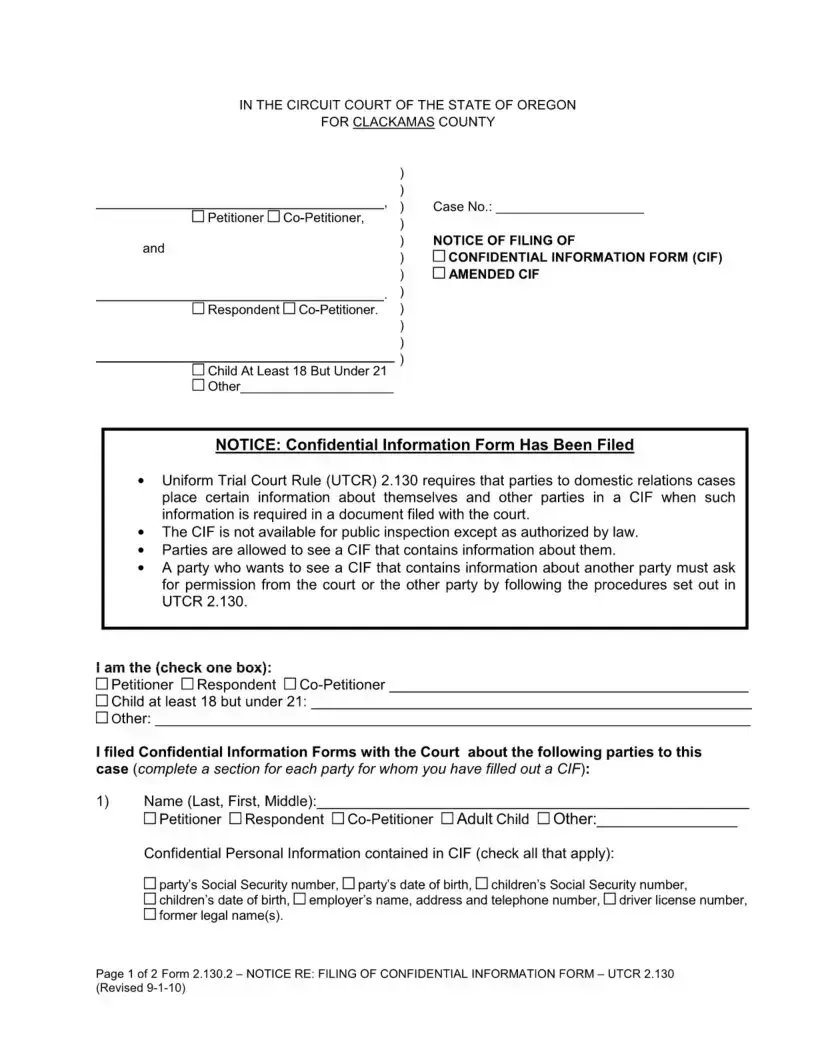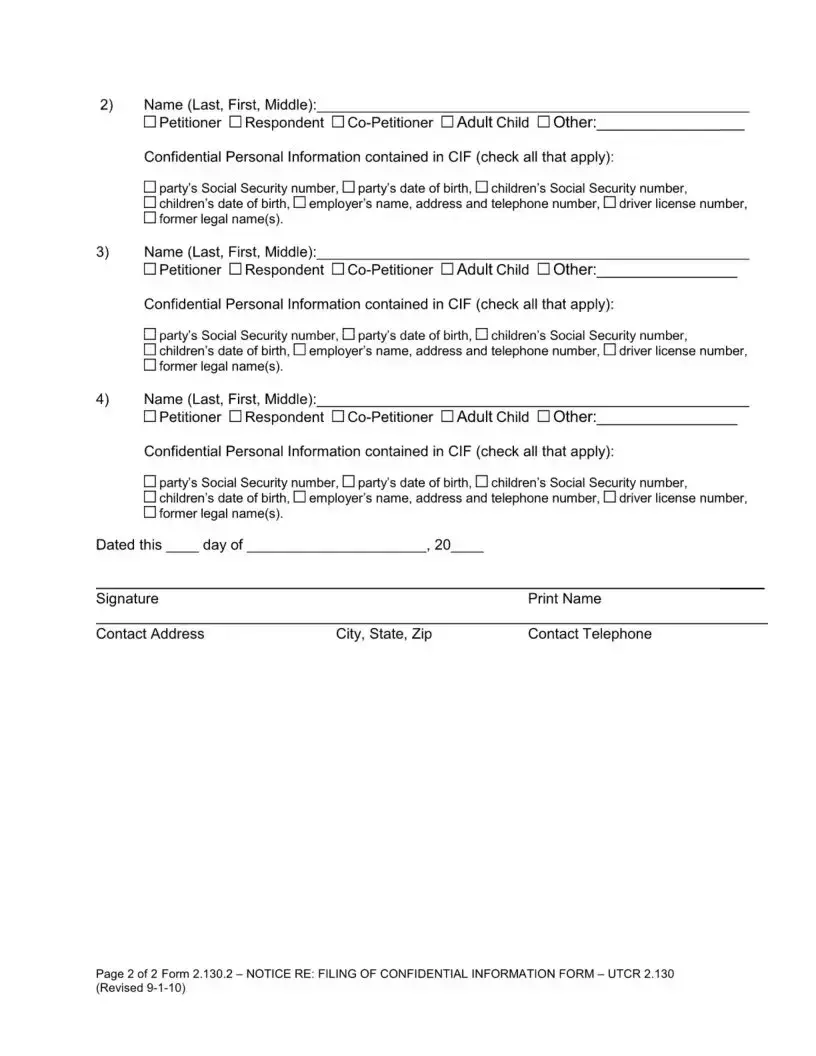NOTICE
Once you have completely filled out the following forms, please check in with the Information Clerk on
the first floor of the court house to have your application reviewed:
•Petitioner’s Confidential Information Form
•Respondent’s Confidential Information Form
•Notice of Filing Confidential Information Form
•Petition for FAPA Restraining Order
•Restraining Order, including Relevant Data Sheet
•Case caption on the Notice to Respondent and Request for Hearing form
Your completed forms MUST be turned in at the Information window BEFORE 11 A.M. to see a
judge the same day. The clerk will need your current, state-issued photo identification to witness your
signature. Once reviewed, the clerk will tell you which court room to appear in at 1P.M. to see the judge.
If you have questions about the restraining order, an advocate may be available at Victims’ Assistance,
located at: 708 Main St. Oregon City, OR 97045 (Just a half block down the street on your left).
You may also call them at 503-655-8616.
For Court Use Only:
Appear at 1 P.M. in court room # |
Located on the |
floor |
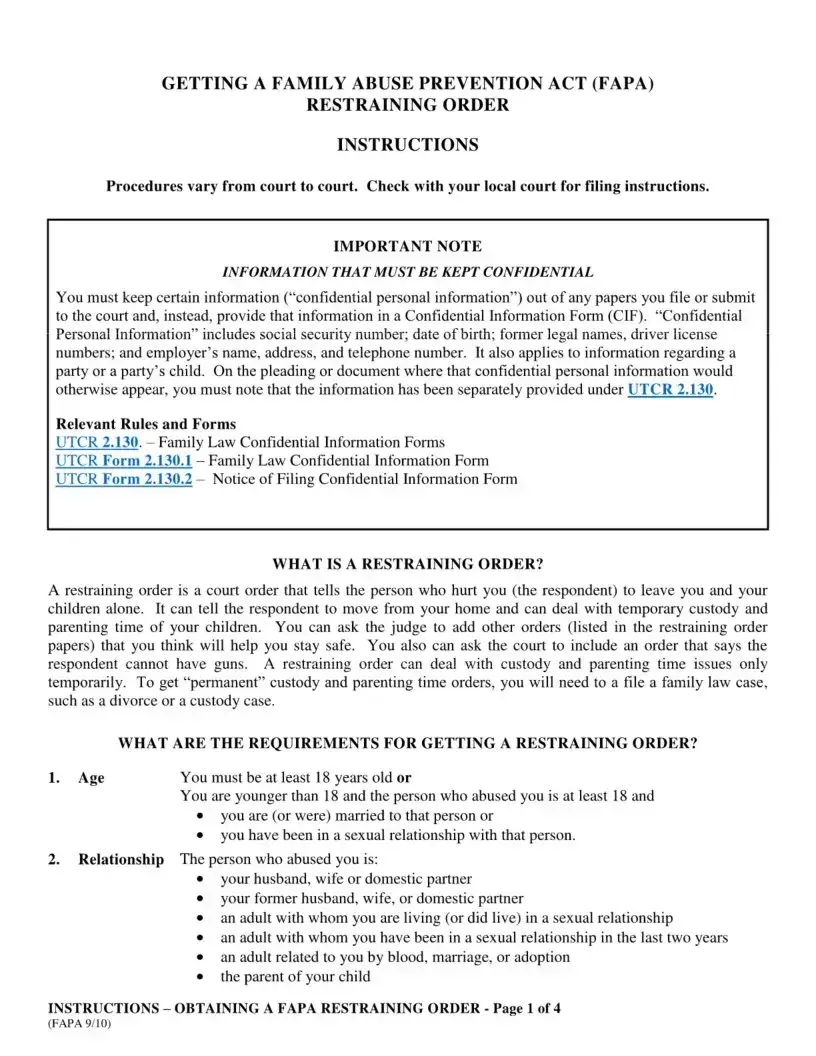
GETTING A FAMILY ABUSE PREVENTION ACT (FAPA)
RESTRAINING ORDER
INSTRUCTIONS
Procedures vary from court to court. Check with your local court for filing instructions.
IMPORTANT NOTE
INFORMA TION THAT MUST RE KEPT CONFIDENTIAL
You must keep certain information (“confidential personal information”) out of any papers you file or submit to the court and, instead, provide that information in a Confidential Information Form (CIF). “Confidential Personal Information” includes social security number; date of birth; former legal names, driver license numbers; and employer’s name, address, and telephone number. It also applies to information regarding a party or a party’s child. On the pleading or document where that confidential personal information would otherwise appear, you must note that the information has been separately provided under UTCR 2.130.
Relevant Rules and Forms
UTCR 2.130. - Family Law Confidential Information Forms
UTCR Form 2.130.1 - Family Law Confidential Information Form
UTCR Form 2.130.2 - Notice of Filing Confidential Information Form
WHAT IS A RESTRAINING ORDER?
A restraining order is a court order that tells the person who hurt you (the respondent) to leave you and your children alone. It can tell the respondent to move from your home and can deal with temporary custody and parenting time of your children. You can ask the judge to add other orders (listed in the restraining order papers) that you think will help you stay safe. You also can ask the court to include an order that says the respondent cannot have guns. A restraining order can deal with custody and parenting time issues only temporarily. To get “permanent” custody and parenting time orders, you will need to a file a family law case, such as a divorce or a custody case.
WHAT ARE THE REQUIREMENTS FOR GETTING A RESTRAINING ORDER?
1.Age You must be at least 18 years old or
You are younger than 18 and the person who abused you is at least 18 and
•you are (or were) married to that person or
•you have been in a sexual relationship with that person.
2.Relationship The person who abused you is:
•your husband, wife or domestic partner
•your former husband, wife, or domestic partner
•an adult with whom you are living (or did live) in a sexual relationship
•an adult with whom you have been in a sexual relationship in the last two years
•an adult related to you by blood, marriage, or adoption
•the parent of your child
INSTRUCTIONS - OBTAINING A FAPA RESTRAINING ORDER - Page 1 of 4
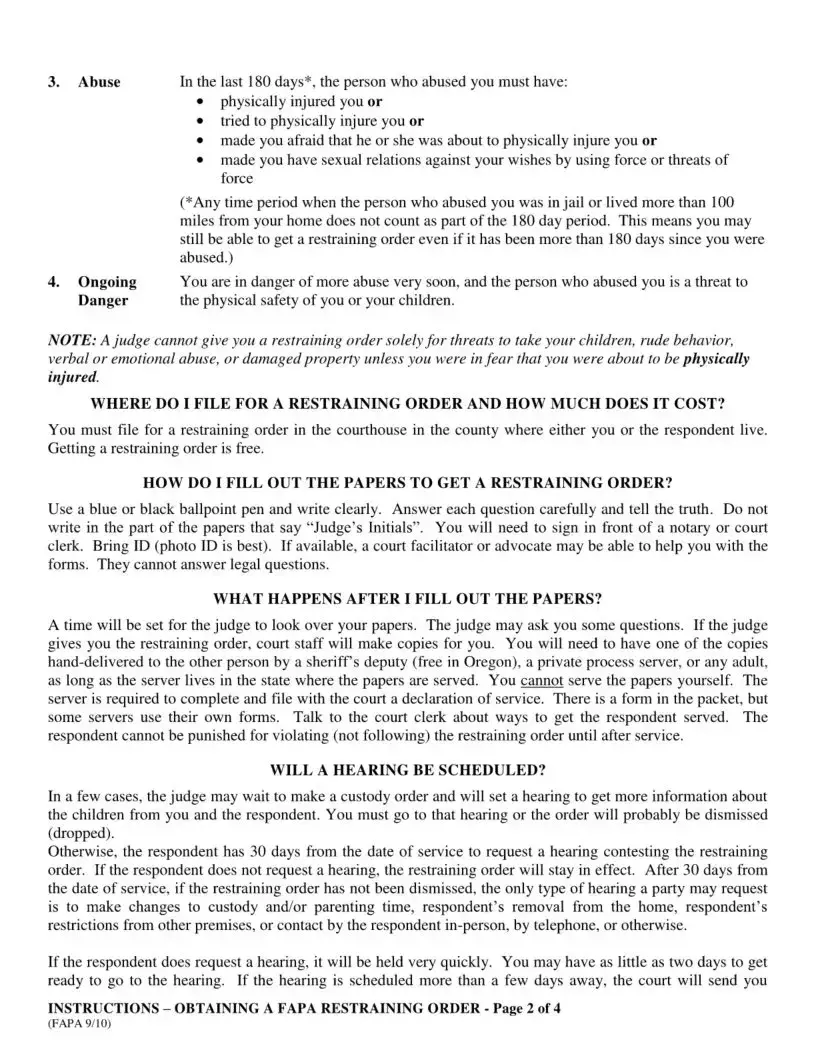
3.Abuse In the last 180 days*, the person who abused you must have:
•physically injured you or
•tried to physically injure you or
•made you afraid that he or she was about to physically injure you or
•made you have sexual relations against your wishes by using force or threats of force
(*Any time period when the person who abused you was in jail or lived more than 100 miles from your home does not count as part of the 180 day period. This means you may still be able to get a restraining order even if it has been more than 180 days since you were abused.)
4.Ongoing You are in danger of more abuse very soon, and the person who abused you is a threat to
Danger the physical safety of you or your children.
NOTE: A judge cannot give you a restraining order solelyfor threats to take your children, rude behavior,
verbal or emotional abuse, or damaged property unless you were in fear that you were about to be physically injured.
WHERE DO I FILE FOR A RESTRAINING ORDER AND HOW MUCH DOES IT COST?
You must file for a restraining order in the courthouse in the county where either you or the respondent live. Getting a restraining order is free.
HOW DO I FILL OUT THE PAPERS TO GET A RESTRAINING ORDER?
Use a blue or black ballpoint pen and write clearly. Answer each question carefully and tell the truth. Do not write in the part of the papers that say “Judge’s Initials”. You will need to sign in front of a notary or court clerk. Bring ID (photo ID is best). If available, a court facilitator or advocate may be able to help you with the forms. They cannot answer legal questions.
WHAT HAPPENS AFTER I FILL OUT THE PAPERS?
A time will be set for the judge to look over your papers. The judge may ask you some questions. If the judge gives you the restraining order, court staff will make copies for you. You will need to have one of the copies hand-delivered to the other person by a sheriffs deputy (free in Oregon), a private process server, or any adult, as long as the server lives in the state where the papers are served. You cannot serve the papers yourself. The server is required to complete and file with the court a declaration of service. There is a form in the packet, but some servers use their own forms. Talk to the court clerk about ways to get the respondent served. The respondent cannot be punished for violating (not following) the restraining order until after service.
WILL A HEARING BE SCHEDULED?
In a few cases, the judge may wait to make a custody order and will set a hearing to get more information about the children from you and the respondent. You must go to that hearing or the order will probably be dismissed (dropped).
Otherwise, the respondent has 30 days from the date of service to request a hearing contesting the restraining order. If the respondent does not request a hearing, the restraining order will stay in effect. After 30 days from the date of service, if the restraining order has not been dismissed, the only type of hearing a party may request is to make changes to custody and/or parenting time, respondent’s removal from the home, respondent’s restrictions from other premises, or contact by the respondent in-person, by telephone, or otherwise.
If the respondent does request a hearing, it will be held very quickly. You may have as little as two days to get ready to go to the hearing. If the hearing is scheduled more than a few days away, the court will send you
INSTRUCTIONS - OBTAINING A FAPA RESTRAINING ORDER - Page 2 of 4
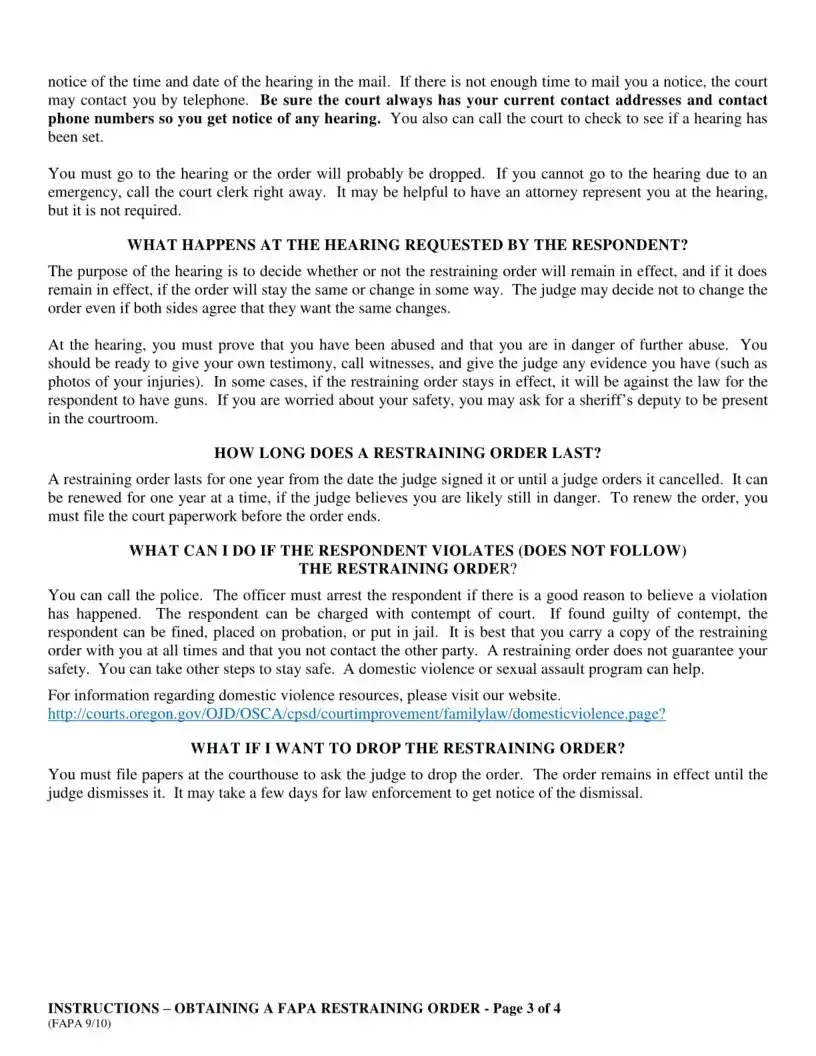
notice of the time and date of the hearing in the mail. If there is not enough time to mail you a notice, the court
may contact you by telephone. Be sure the court always has your current contact addresses and contact
phone numbers so you get notice of any hearing. You also can call the court to check to see if a hearing has been set.
You must go to the hearing or the order will probably be dropped. If you cannot go to the hearing due to an emergency, call the court clerk right away. It may be helpful to have an attorney represent you at the hearing, but it is not required.
WHAT HAPPENS AT THE HEARING REQUESTED BY THE RESPONDENT?
The purpose of the hearing is to decide whether or not the restraining order will remain in effect, and if it does remain in effect, if the order will stay the same or change in some way. The judge may decide not to change the order even if both sides agree that they want the same changes.
At the hearing, you must prove that you have been abused and that you are in danger of further abuse. You should be ready to give your own testimony, call witnesses, and give the judge any evidence you have (such as photos of your injuries). In some cases, if the restraining order stays in effect, it will be against the law for the respondent to have guns. If you are worried about your safety, you may ask for a sheriff’s deputy to be present in the courtroom.
HOW LONG DOES A RESTRAINING ORDER LAST?
A restraining order lasts for one year from the date the judge signed it or until a judge orders it cancelled. It can be renewed for one year at a time, if the judge believes you are likely still in danger. To renew the order, you must file the court paperwork before the order ends.
WHAT CAN I DO IF THE RESPONDENT VIOLATES (DOES NOT FOLLOW)
THE RESTRAINING ORDER?
You can call the police. The officer must arrest the respondent if there is a good reason to believe a violation has happened. The respondent can be charged with contempt of court. If found guilty of contempt, the respondent can be fined, placed on probation, or put in jail. It is best that you carry a copy of the restraining order with you at all times and that you not contact the other party. A restraining order does not guarantee your safety. You can take other steps to stay safe. A domestic violence or sexual assault program can help.
For information regarding domestic violence resources, please visit our website. http://courts.ore2on.2ov/OJD/OSCA/cpsd/courtimprovement/familylaw/domesticviolence.pa2e?
WHAT IF I WANT TO DROP THE RESTRAINING ORDER?
You must file papers at the courthouse to ask the judge to drop the order. The order remains in effect until the judge dismisses it. It may take a few days for law enforcement to get notice of the dismissal.
INSTRUCTIONS - OBTAINING A FAPA RESTRAINING ORDER - Page 3 of 4
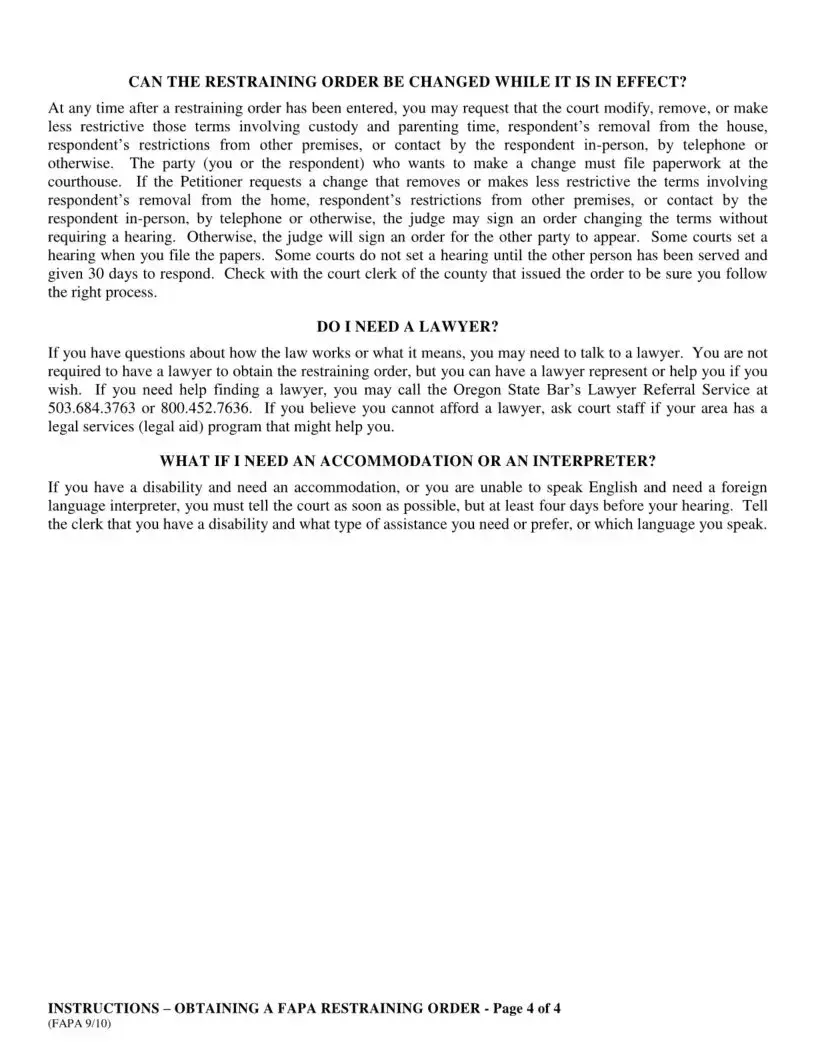
CAN THE RESTRAINING ORDER BE CHANGED WHILE IT IS IN EFFECT?
At any time after a restraining order has been entered, you may request that the court modify, remove, or make less restrictive those terms involving custody and parenting time, respondent’s removal from the house, respondent’s restrictions from other premises, or contact by the respondent in-person, by telephone or otherwise. The party (you or the respondent) who wants to make a change must file paperwork at the courthouse. If the Petitioner requests a change that removes or makes less restrictive the terms involving respondent’s removal from the home, respondent’s restrictions from other premises, or contact by the respondent in-person, by telephone or otherwise, the judge may sign an order changing the terms without requiring a hearing. Otherwise, the judge will sign an order for the other party to appear. Some courts set a hearing when you file the papers. Some courts do not set a hearing until the other person has been served and given 30 days to respond. Check with the court clerk of the county that issued the order to be sure you follow the right process.
DO I NEED A LAWYER?
If you have questions about how the law works or what it means, you may need to talk to a lawyer. You are not required to have a lawyer to obtain the restraining order, but you can have a lawyer represent or help you if you wish. If you need help finding a lawyer, you may call the Oregon State Bar’s Lawyer Referral Service at 503.684.3763 or 800.452.7636. If you believe you cannot afford a lawyer, ask court staff if your area has a legal services (legal aid) program that might help you.
WHAT IF I NEED AN ACCOMMODATION OR AN INTERPRETER?
If you have a disability and need an accommodation, or you are unable to speak English and need a foreign language interpreter, you must tell the court as soon as possible, but at least four days before your hearing. Tell the clerk that you have a disability and what type of assistance you need or prefer, or which language you speak.
INSTRUCTIONS - OBTAINING A FAPA RESTRAINING ORDER - Page 4 of 4
Information about the Confidential Information Form (CIF)
What is a CIF?
Most court files may be viewed by the public. Uniform Trial Court Rule (UTCR) 2.130 requires certain confidential personal information to be protected from public disclosure. That is done by providing the information in a separate form. After you file your papers, the court keeps the form separate from the part of the court file that may be viewed by the public. The form is UTCR Form 2.130.1, known as the Confidential Information Form, or CIF.
What information does a CIF make confidential?
•The information protected by the CIF is social security numbers, birth dates, driver license numbers, and former legal names. Also protected is the name, address and telephone number of a party’s employer.
•The CIF should only be used to protect the information described above. There may be other information in your court papers that you do not want the public to be able to see, such as bank account or credit card numbers. The separate process for protecting that information is described in UTCR 2.100. The instructions and forms can be viewed here: UTCR 2.100 Instructions and UTCR 2.100 Long Form.
How do I know when I need to put information in the CIF?
When you file a document with the court that requires you to include the protected information listed above, that information must only be provided to the court in a CIF, and must not be listed in any other document to be filed. Where you would otherwise provide the information in the document to be filed, you must make a notation that the information has been provided in the CIF. For example, if a document requires a party’s frill social security to be listed, you must not list the social security number, but must instead write in the document that the information has been “separately filed under UTCR 2.130.” The online court forms already include
this notation where necessary.
Do I need to file more than one CIF?
•In most cases, yes. You must fill out a CIF for yourself, and if the documents you are filing with the court require confidential personal information about the other party, you must also fill out a separate CIF with the other party’s information. If your case involves minor children you should include their information in your CIF. You do not need a separate CIF for your minor children. You will; however, need to fill out a separate CIF for any children between you and the other party who are unmarried, and between the ages of 18 and 21. These children are considered legal parties to the case.
•If there is CIF information you do not know when you file your papers, but you learn it at a later and file a document that requires it; or if the information changes during your case, you must file an amended CIF that provides the new or updated information.
•The CIF rule requires you to redact - black out or erase - confidential personal information from any attachments to documents you file with the court, and to make a note on the attachment that the information has been provided in the CIF. The only time you must not segregate confidential personal information from a document, is when you are required to attach a court certified copy of a document. Documents that are required to be court certified must not be altered in any way.
Does the other party get copies of a CIF I file?
•You are not required to serve the CIFs on the other party, although you may share a CIF with the other party if you chose to do so. You are required to fill out UTCR Form 2.130.2 Notice of Filing CIF and file it with the court. A copy of this Notice must be mailed or delivered to all parties to the case. A certificate of service must be filed with the court, showing the date the notice was mailed or delivered, and to whom. The Notice may be also served by process server, Sheriff, or third party. In this case, the proof of service form should list the Notice of Filing CIF as a document that was served.
•There are steps the other party and other people can go through to ask the court to allow them access to a CIF that you have filed. UTCR 2.130 explains this process in detail. The CIF rule can be read at UTCR 2.130 CIF Rule and Forms.
Please Note: If your case already contains confidential personal information that was previously filed, those documents are not affected by this rule. The court is under no obligation to remove confidential personal information from any document; regardless of when it’s filed. If you would like to remove confidential information from a document that’s already been filed with the court, you will need to follow a separate process that is described in UTCR 2.110(4), which you can read more about here: UTCR 2.110 Protected Personal Information Procedures. The form is available here: UTCR 2.110 Form
IN THE CIRCUIT COURT OF THE STATE OF OREGON
FOR CLACKAMAS COUNTY
|
|
) |
|
|
|
) |
Case No.: |
|
|
) |
|
|
) |
CONFIDENTIAL INFORMATION FORM (CIF) FOR |
|
Petitioner |
) |
|
) |
PROTECTED PERSON (PETITIONER) IN FAMILY |
|
|
and |
|
) |
ABUSE PREVENTION ACT (FAPA) CASES |
|
) |
Amended CIF |
|
|
|
|
) |
|
|
Respondent |
|
This document is not accessible to the public |
|
|
or other parties. See UTCR 2.130 |
|
|
|
ATTENTION COURT STAFF: THIS IS A RESTRICTED-ACCESS
DOCUMENT.
The information below is about: Petitioner
Name (Last, First, Middle):
The names of the parties and the children, as well as the children’s ages, are NOT confidential.
Date of Birth of Petitioner:
Children's Names (Last, First, Middle) |
Date of Birth |
Page 1 - Form 2.130.1 - CONFIDENTIAL INFORMATION FORM FOR PETITIONERS IN FAPA CASES- UTCR 2.130 (Revised 11-1-10)
Ihereby declare that the above statements are true to the best of my knowledge and belief and that I understand they are made for use as evidence in court and are subject to penalty for perjury.
Date:Signature:
Type or Print Name:
COMPLETED AND SUBMITTED BY:
Petitioner
NOTE TO COURT STAFF: This Confidential Information Form is not available to the opposing party or his/her attorney, or to the public; except for the state and law enforcement. See UTCR 2.130
NOTICE TO PETITIONER:
The Sheriff is required by law to provide you with a true copy of the proof of service which shows when the Restraining Order has been served.
If you would like to also receive an email message and/or cell phone text message advising you of when the Restraining Order has been served on the Respondent and another message 30 days before the Order expires, please provide the information requested below. This information will be given to the sheriff’s office in the county where the Restraining Order was obtained.
This is voluntary—you are not required to provide this information.
Your cell phone number:
Your cell phone carrier (ATT, Verizon, etc.):
Your email address:
Note: If this information changes, you must notify the Sheriff’s office of the new information in order to receive the notice by email or cell phone text message.
Page 2 - Form 2.130.1 - CONFIDENTIAL INFORMATION FORM FOR PETITIONERS IN FAPA CASES- UTCR 2.130 (Revised 11-1-10)
IN THE CIRCUIT COURT OF THE STATE OF OREGON
FOR CLACKAMAS COUNTY
)
)
Case No.:
Petitioner Co-Petitioner,
|
and |
) |
NOTICE OF FILING OF |
|
) |
CONFIDENTIAL INFORMATION FORM (CIF) |
|
|
|
|
) |
AMENDED CIF |
|
|
. ) |
|
|
|
Respondent Co-Petitioner. ) |
|
|
|
) |
|
|
|
) |
|
|
|
Child At Least 18 But Under 21 |
|
|
|
Other |
|
NOTICE: Confidential Information Form Has Been Filed
•Uniform Trial Court Rule (UTCR) 2.130 requires that parties to domestic relations cases place certain information about themselves and other parties in a CIF when such information is required in a document filed with the court.
•The CIF is not available for public inspection except as authorized by law.
•Parties are allowed to see a CIF that contains information about them.
•A party who wants to see a CIF that contains information about another party must ask for permission from the court or the other party by following the procedures set out in UTCR 2.130.
I am the (check one box):
Petitioner Respondent Co-Petitioner
Child at least 18 but under 21:
Other:
I filed Confidential Information Forms with the Court about the following parties to this
case (complete a section for each party for whom you have filled out a CIF):
1)Name (Last, First, Middle):
Petitioner Respondent Co-Petitioner Adult Child Other:
Confidential Personal Information contained in CIF (check all that apply):
party's Social Security number, party's date of birth, children's Social Security number,
children’s date of birth, employer’s name, address and telephone number, driver license number, former legal name(s).
Page 1 of 2 Form 2.130.2 - NOTICE RE: FILING OF CONFIDENTIAL INFORMATION FORM - UTCR 2.130 (Revised 9-1-10)
2)Name (Last, First, Middle):
Petitioner Respondent Co-Petitioner Adult Child Other:
Confidential Personal Information contained in CIF (check all that apply):
party’s Social Security number, party's date of birth, children's Social Security number, children's date of birth, employer's name, address and telephone number, driver license number, former legal name(s).
3)Name (Last, First, Middle):
Petitioner Respondent Co-Petitioner Adult Child Other:
Confidential Personal Information contained in CIF (check all that apply):
party’s Social Security number, party’s date of birth, children's Social Security number,
children’s date of birth, employer's name, address and telephone number, driver license number, former legal name(s).
4)Name (Last, First, Middle):
Petitioner Respondent Co-Petitioner Adult Child Other:
Confidential Personal Information contained in CIF (check all that apply):
party's Social Security number, party's date of birth, children's Social Security number,
children’s date of birth, employer’s name, address and telephone number, driver license number, former legal name(s).
Dated this |
day of |
, |
20 |
Signature |
|
|
Print Name |
Contact Address |
City, State, Zip |
Contact Telephone |
Page 2 of 2 Form 2.130.2 - NOTICE RE: FILING OF CONFIDENTIAL INFORMATION FORM - UTCR 2.130 (Revised 9-1-10)
